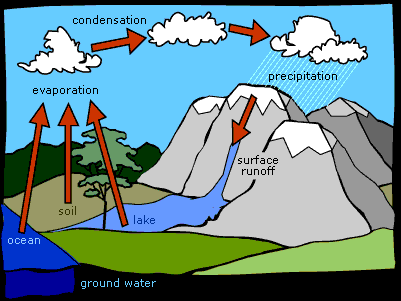
A diagram showing the effects of ice wedging (thermal-expansion).
This type of weathering can include thermal-expansion. Thermal expansion occurs when joints (cracks) in rocks are filled with water. As the water freezes it expands and cracks the rock. As the ice melts, the space left by the ice wedge is larger than it was before the process occurred. This leaves a greater area to be filled with water the next time the process occurs thus causing the volume of water to expand even more. As this process occurs multiple times high in the mountains the large rocks eventually break apart. Other examples of physical weathering that can occur near the sand dunes are root wedging, and crystallization wedging. Both of which work in very similar ways to ice wedging except for the material doing the weathering is either a root or a crystal forming.
Chemical weathering can include acid rain or any other process that breaks down rocks through a chemical means.
After the rocks are weathered high in the mountains, the weathered material is carried into the San Luis Valley by an extensive system of rivers surrounding the dunes.

A map showing the system of creeks surrounding the dunes.
These rivers (creeks) include Little Medano Creek, Medano Creek, Castle Creek, Buck Creek, and Garden Creek. All of these streams flow out of the Sangre De Christo Mountains and deposit small bits of weathered material at the base of the dunes. As for the San Juan Mountains, the processes in which these mountains are weathered are similar to the process at work weathering the Sange De Christo Mountains. The difference lies in the erosion of the weather material. Since the San Juan Mountains are located across the San Luis Valley from the dunes, the weathered material from the San Juan Mountains is deposited in the valley. Since the valley is flat and desert-like and the Mountains surrounding it are tall and often cold, there is wind always present. This southwesterly wind is what accounts for the transport of sand from across the valley to the dune field.

Part of the hydrologic cycle can also be observed at
the sand dunes. As snow falls atop the Sangre De Christo and the San Juan
Mountains, it melts and causes a spring time run-off. When the glaciers melt, they feed the streams
I mentioned before. An interesting fact
about Medano Creek is that part of it is only visible during the time of year
at which the snow melts. After this,
there is not enough water to saturate (fill) the phreatic zone, and the creek
in turn goes underground where the rest of the river is year round. The dune field has lots of pore space which
can absorb lots of water. Since the San
Luis Valley is desert-like, much of the water evaporates and returns to the
ground as rain, or flows into larger rivers and heads towards lowland bodies of
water.
There are
many soils that can be found surrounding the Great Sand Dunes. For example there is lots of sand which can be
found due to the shape of the valley and the processes of weathering and
erosion. There can be found soils with
organic compounds because although the San Luis Valley is a desert the bases of
the Sangre De Christo and San Juan Mountains are covered with indigenous plant
life such as Pinon Trees.
a video showing the awesome surges that occur in Medano Creek. As sand erodes and flows in the river its builds tiny dams that hold water until they break causing these surges! Can only be seen in very,very few places on earth.